| |
| July
2006 |
Ballard
Canyon : a Photo Journal |
|
|
On
down the road to meet Steve Beckmen at his Purisima
Mountain Vineyard. Although Stolpman predated it, arguably, it may have been Purisima Mtn that put Ballard Canyon on the map - so to speak. After apologizing for the lack of shade (it was a hot day), Steve
described the location. He told us that Purisima Mtn was similar in soil to similar to Tierra
Alta and Stolpman - with the biggest difference being that his vineyards are
facing south and southwest. Same Linne clay/loam/chalky
limestone - which could be right at the surface or well below
it. After making wines with Stolpman fruit, Steve was impressed
with quality of Syrah and Grenache, and to a lesser extent
Mourvedre, so the Beckmen family bought this piece of Ballard Canyon in 1996.
Planted
in late '90s over 3 yrs (40ac in '97, 60ac in '98, and 30ac in '99),
Purisima Mtn is now 125 acres, with 15 Sauvignon Blanc, 12 Cabernet,
and the rest Rhone varieties. About 60 acres of Syrah, and
about 30 acres of Grenache - a standout on this property. Also has some Counoise (only goes into the LeBec bottlings
as 5-12% of the blend for "textural and balance purposes"). The vineyard can get quite windy, so most of the Grenache is in sheltered swales, as it tends toward shatter in windy conditions at the time of flowering. So much so that Steve joked about "stem
dropping," referring to the shattered clusters that get dropped. Trellising is mostly vertical
shoot position. Steve had just done some hedging
of both sides and tops, and leaf and lateral shoot removal
this time of year to the Syrah. But, he lets everything else go, because there's too much growth laterally
after hedging.
The Marssanne is on bilateral cordon. Steve
prefers the bottom section (flatter part) of the vineyard,
rather than the hillside portion - and says, though it is more
vigorous, it has more character and flavor.
Since 2002, he has been trying biodymanic farming. Steve and his family
live on the property, wich give added meaning to a "self sustaining environment."
Currently, they're doing lots of gardening, and this will be followed by adding livestock in the next
few years (cows, goats, etc.) Steve, hasn't used sulphur for last couple
of years - uses something mineral oil-based item for mildew
- but he says it's mostly dry here anyway. He has noticed higher levels
of nitrogen, and fewer stuck fermentations since use of
biodynamics. About 85% of the fruit goes to the Beckmen label
- sells primarily Syrah to about 10 other winemakers. Block
6 was started the same time as the biodynamic program, so
he could follow it how well the block performed (3 selections
- 174, 383, Estrella).
|
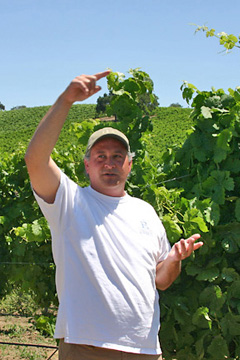 |
|
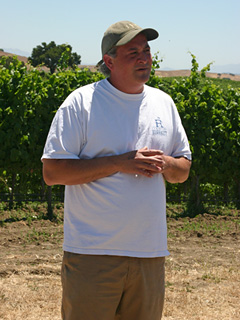 |
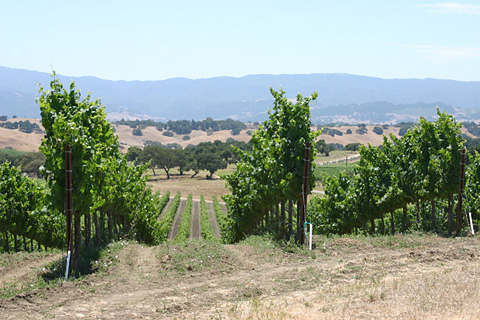 |
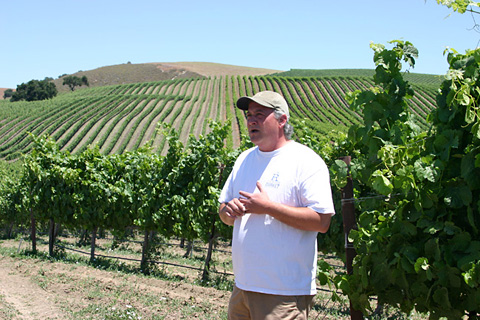 |
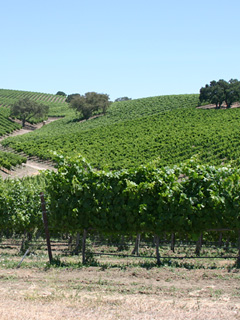 |
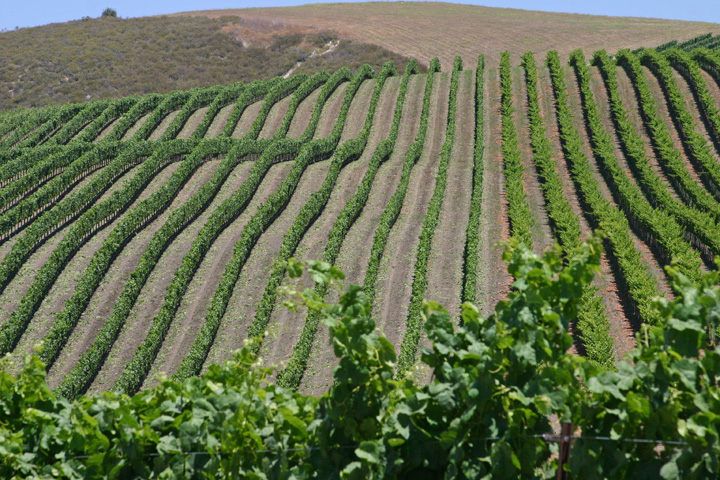 |
|
On down the road to Larner Vineyard, to meet with
Mike Larner (left). The temperature was rising, so everybody grabbed a bottle of water or two as we departed the vans, and proceeded to walk the vineyard with Mike. Lunch and wine would follow, so getting hydrated made plenty of sense.
Everything
here done by hand, and Mike says that his vineyard admittedly "caters to small producers." No section of
the vineyard is bigger than 2.5 acres. Before planting, the Larners started with Jeff Newton. They looked at Purisima, and considered planting many varieties, but
ultimately settled on Rhones. Their farming tries to follow their clients dictates -and since they're
a smaller vineyard, they work with smaller clients.
Mike was asked when Larner Vineyard would start making its own wines. Since he just finished
UC Davis, he replied "hopefully soon," indicating he'd start small - probably with
300 cases. Of the 34 ac, there are 23 ac syrah, 6ac grenache, 2.5ac viognier,
2 ac mouvedre, and curiously - 1.5ac malvasia bianca. He was inspired by Wild Horse winery's example of this varietal -
musty with good acidity. It's rare - possibly only two vineyards from here
to Monterey have it planted. Mike names his vineyard sections, so Little Italy
is the malvasia bianca, Long Shadow is another, La Paloma
another. Call me crazy, but somehow this does seem easier to keep track of than "Section 3" or "Block 12." Chalk soils predominate here - but, you've got to dig deep to get to it. Most of
the vineyard looks like beach sand, but that sand can be 7' deep, with loam and clay deeper within. The grenache seems to be a bit darker
here - clones include 136, 362, 513, Larner clone. There was a nice
replica of the Ballard General Store -and, as a bit of trivia, the town
of Ballard is not actually in Ballard Canyon.
Syrah-based plantings
are the speciality here, so Mike is trying
some experimental sections of planting of 20 plants per row
to see which clones do well in the soil. Same trellising and same soils, just not as much chalk here. Apparently, clone 525 does nicely. On another 25 ac on the north side of the
property, Mike finds that Estrella clone is more California-like; 877 and 3 are more coffee/mocha
and Aussie-like, while 383, 174 more meaty and Rhone like. |
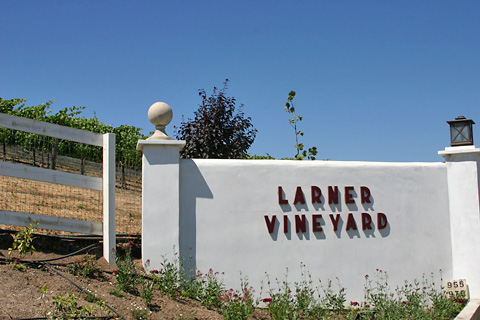 |
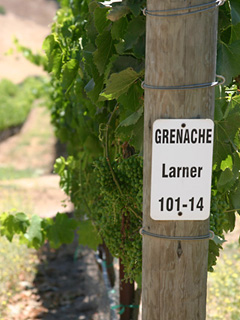 |
| |
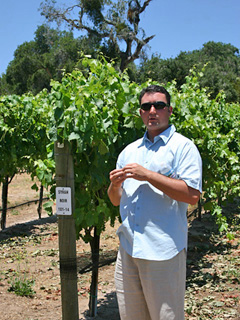 |
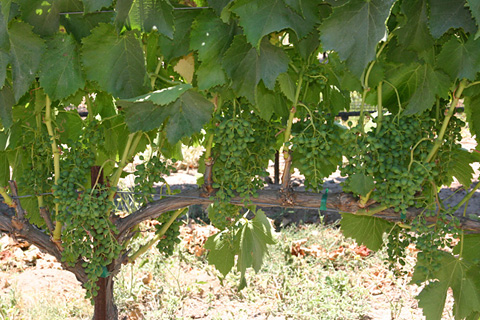 |
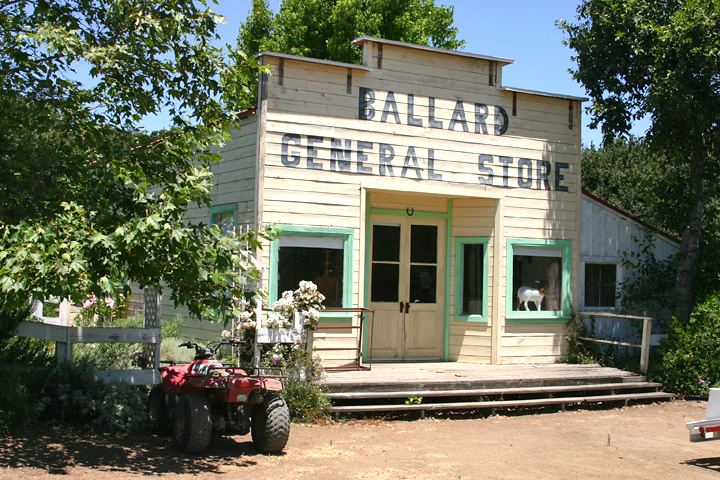 |
| We finished up the tour and had a fabulous lunch and tasting in the Larner barn. It was a wonderful experience to have walked each of these vineyards, and then to be able to taste wines from many of the producers using the fruit from Tierra Alta (Tensley, Kaena), Stolpman (Carena, Holus Bolus), Purisima Mountain (Beckmen, Kenneth Crawford), and Larner (McPrice Myers, Herman Story, Jelly Roll). The day finished with our ride back to Los Olivos about 3:00. Free tasting was available at the Tensley tasting room, but it was time to head back to reality. |
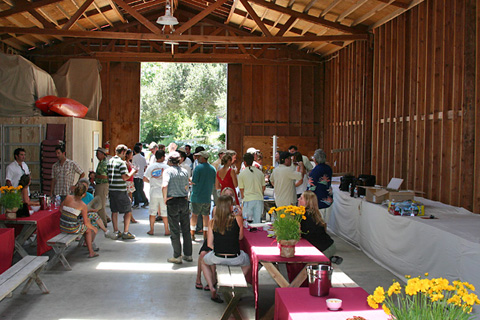 |
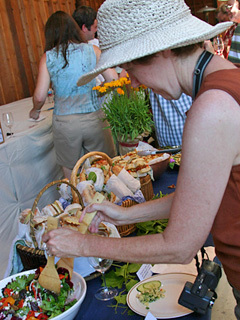 |
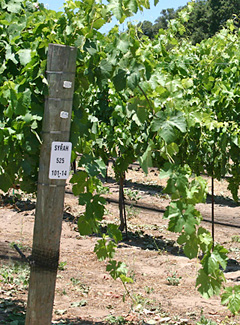 |
|
| |
|
|
| July
2006 |
Ballard Canyon : a Photo Journal |
|
|